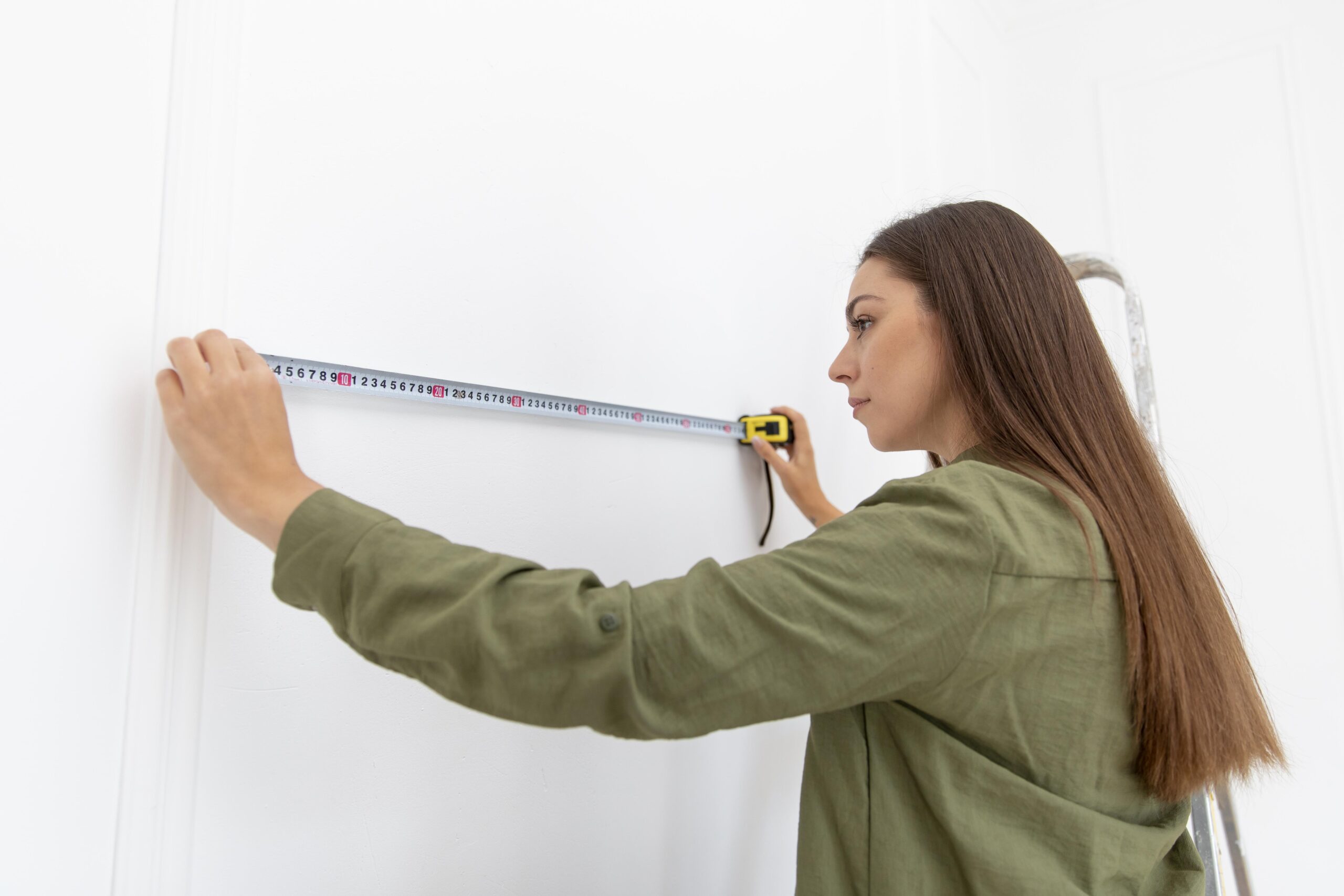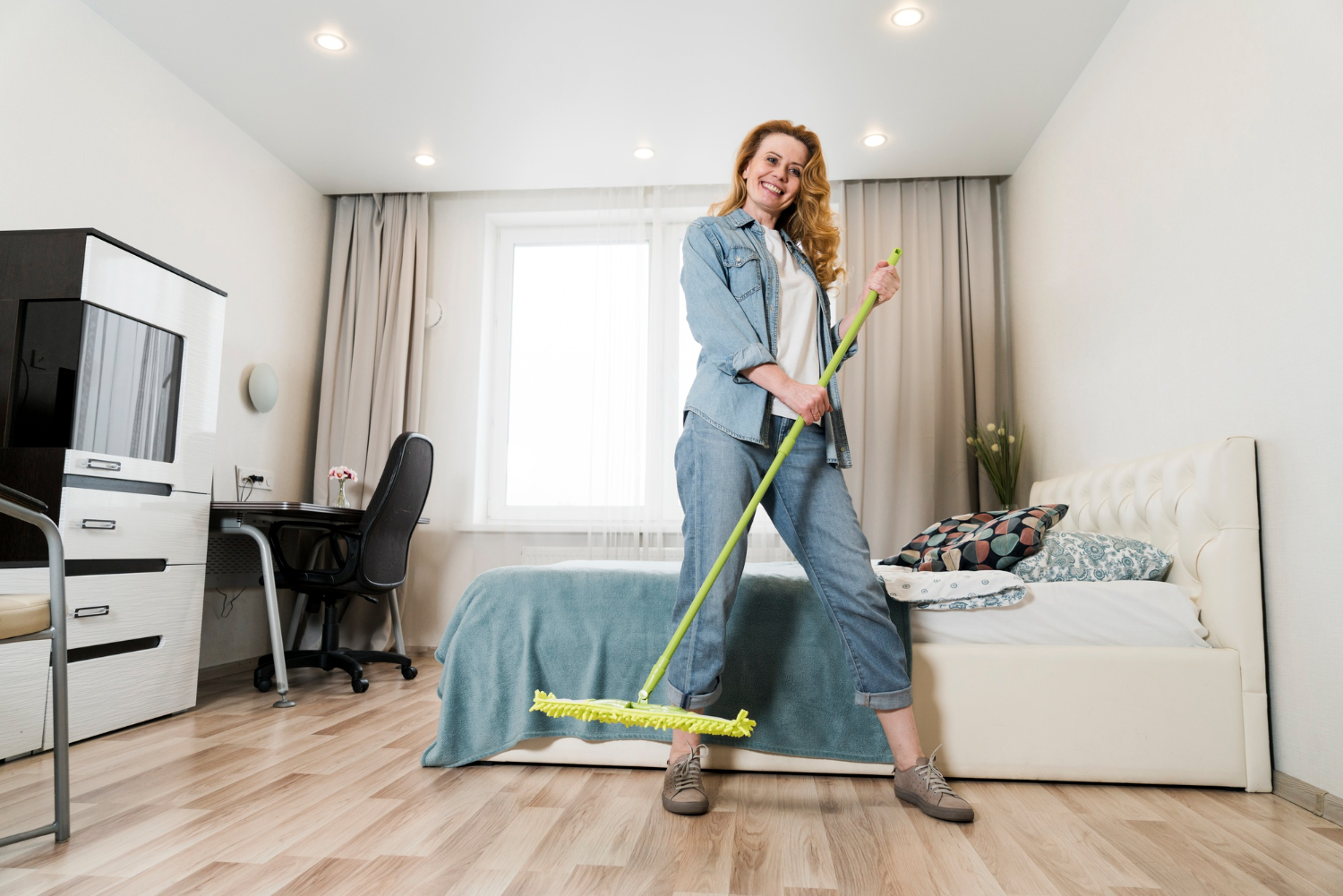People commonly use square footage and square meters to measure space in a property. To determine dimensions, recall your high school geometry lessons, where you calculate the area of a square by multiplying its length and width.
This metric plays a crucial role in assessing a property’s value. To begin measuring an apartment’s dimensions, gather the following tools: paper and pencil, a calculator, and either a measuring tape or a laser measuring device.
Real estate agents commonly utilize an electronic laser distance-measuring device. If you have one, position it against a wall and point it directly at the opposite wall. The square footage will then be displayed on the device’s screen. If you don’t have a laser device, a tape measure can serve as an alternative.
Start by measuring the length and width of each room using a tape measure. Then, multiply these dimensions to find the footage of each room (for example, 10 feet by 17 feet equals 170 square feet, or 3.048 m by 5.1816 m equals 15.79 sq m). Add up all the individual room measurements to find the living space.
You don’t have to be an appraiser or a real estate agent to figure out how big an apartment is. You can measure the square footage of your home quickly by just following these steps.
Common Square Footage Measures
1 Meter = 3.28084 Feet
1 Square Meter = 10.7639 Sq. Feet
How to measure your apartment?
If your property is a perfect rectangle, you can find its square footage by multiplying the length and width. For instance, if your house measures 60 feet wide by 40 feet long, then it totals 2,400 square feet (60 x 40 = 2,400).
So, when we convert dimensions from feet to meters:
60 ft x 0.3048 m/ft=18.288 m
40 ft x 0.3048 m/ft=12.192 m
18.288 m x 1.192 m=223.05 sq m
However, most properties have way more complex floor plans. These straightforward steps can guide you in measuring the footage accurately:
1. Sketch out a floor plan of your space (using online tools) and label all the rooms that require measurement. Remember to include hallways and entryways as separate areas.
2. Measure the length and width of each room in feet and calculate the footage by multiplying these dimensions. For instance, if a bedroom measures 12 feet by 20 feet, its total area is 240 square feet (Or 12 ft x 0.3048 m/ft=3.6576 m, 20 ft x 0.3048 m/ft=6.096 m, 3.6576 m x 6.096 m=22.3 sq m).
Write measurements of each room on your sketch.
3. After measuring all the rooms, add up the room dimensions to determine the total square footage of your home. Also, exclude spaces like basements or attics.
For example, write down the dimensions of a bedroom: 3 by 3 meters or 9 square meters. A living room is 3.5 by 2.5 meters or 8.75 square meters. A kitchen is 2 by 3 meters or 6 square meters.
The size of our apartment as of right now is 9 + 8.75 + 6 = 23.75 square meters.
Keep going until you have measured and added up all the rooms.
Habitable space vs. non-habitable
In real estate terms, there is a difference between “rentable vs. usable” space. Gross square footage refers to the total square footage of an apartment unit, including wall thicknesses, columns, and structural elements. On the other hand, net square footage represents the usable or livable space inside the unit without considering those structural elements. The net area gives a picture of how much functional space is available for residents.
For that matter, French law, the Loi Carrez, provides a uniform method for calculating property measures and defines what constitutes a “livable” surface area. The habitable surface area especially refers to a livable floor area within the property. An expert known as a geometre measures a property.
Not every nook and cranny in the wall counts toward Loi Carrez’s measurement. For instance, spaces beneath ceilings lower than 180 cm, which are common in rooftop apartments, are not considered to be habitable spaces.
The habitable area of a property must be specified in the Promesse de Vente.
This does not include:
-
- Stairwells and stairs
-
- Balconies and terraces
-
- Anything under 1.8 meters (5’10”), such as a mezzanine or cellar
-
- Separating walls
Why Does Loi Carrez Matter?
-
- Guarantees you’re not overpaying for unusable space, but rather a fair price per square meter.
-
- Allows you to compare different properties based on their actual liveable area accurately.
-
- You have the legal right to modify the sale price if the listed surface area is off.
-
- Under the Loi Carrez, fairness and transparency are encouraged in the French real estate market. Being aware of this can safeguard your investment and ensure you’re getting exactly what you pay for.
So, a good rule of thumb to ensure you’re taking proper measurements is to exclude space you can’t walk on or live in.
Even when completed, garages and basements are typically not included in the overall square footage. Since basements are constructed below grade or below ground level, they are usually excluded.
Finished attic areas may be included in calculating your house’s overall square footage but with certain rules (such as ceiling heights).
Built-in closets are frequently included in a house’s footage, but not always. Any space within a house with walls, floors, ceilings, and heating is usually considered part of the footage. Nevertheless, closets that don’t fit the criteria, such as those in an unheated basement, would probably be excluded from the calculation.
If in doubt, consult the experts
If figuring out the square feet seems like too much work, consider hiring a professional appraiser or geometre to do it for you.
Furthermore, in challenging locations, seasoned specialists might just eyeball it. Because of this, various appraisers may calculate the same home’s square footage slightly differently.
Measuring Sqft in Odd-Shaped Rooms
Not every floor has an identical square or rectangle with four walls. In a similar vein, many rooms have irregular shapes with nooks and various angled walls.
Given this, segmenting an area into many squares or rectangles is an easy approach to measuring odd-shaped rooms.
For example, to measure the area of a triangular room, you need to measure the base of the triangle, which is the length of the longest wall. Then, measure the height from the base to the top of the triangle. Multiply these two measurements. Divide by two to calculate the footage of the room.
On the other hand, if your room is tapered, you should do the following. Here’s an example:
One side of the 90-degree corner is 20 feet, the other is 15 feet, and the side across from the 20 feet side is 25 feet.
First step: multiplying 20 by 15 is 300 square feet.
In the second step, calculate the triangle’s area of 15 x 5 (the difference between 25 and 20), and you get 75 square feet. However, because it’s a triangle, you must divide the 75 square feet in half to get 37.5 square feet. So, the space is 300 + 37.5 = 337.5 square feet.
Other options
For rooms that are not precisely square, you can use a room size calculator. Another option is to divide the space into smaller squares, measure and compute each one’s square footage, and then add them all up to get the total.
If a room features an alcove, like a living room with a designated area for a home office, measure that area separately and include it in the total square footage of the room. The same principle applies to rooms with built-in closets; measure each built-in closet by multiplying its length by its width.
For a circular (or semi-circular) room, measure the radius from the center to the edge, then multiply the result by pi (3.14). If it’s a semicircle, divide that figure by two. Add up all of the totals to get the final calculation. Make sure to measure all areas with heating and cooling systems.
France introduced rules for advertising rental properties a few years ago. Among other requests, the exact surface area of the property in square meters must be provided. So, before posting an advertisement for your French apartment, make sure to learn how to calculate the dimensions of your property accurately.









